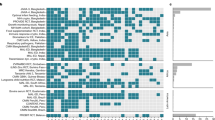Abstract
Objective: We tested the hypothesis that growth faltering in rural Guatemala starts earlier than between 3–6 months of life, as generally assumed.
Methods: The sample included children from the INCAP longitudinal trial (1969–1977), who had adequate birth weight (>−1 s.d.) (n=79). Two groups were formed according to weight-for-age (WAZ) at 3 y: Group A: WAZ<−2 s.d. (growth-retarded), and Group B: WAZ ≥−2 s.d. Weight increments were computed and sex- and gender-specific deficits in weight increments from 0–36 months were calculated by comparing values of the WHO/CDC reference data. For the period between 0–12 months, weight increments were also compared to velocity standards: (1) the Fels data and (2) the WHO growth curves for breast fed infants.
Results: At 3 y of age, growth-retarded children were 3.6 kg smaller than the WHO/CDC median. Depending on the reference data used, between 19 and 34% of the deficit at 3 y of age was due to failure to thrive during the first 3 months of life, an additional 12–19% occurred between 3 and 6 months and 12–25% between 6 and 9 months. By 12 months of age, infants had accumulated 45–80% of their total deficit in weight at 3 y of age. Compared to group B, children from group A had greater morbidity during their first 9 months of life, and their mothers had poorer nutritional status at 3 months postpartum. There were indications that children from group A came from more deprived families.
Conclusions: Growth faltering starts soon after birth in rural Guatemala and thus, effective interventions should be targeted to mothers and their infant as early as possible during the first year.
Sponsorship: Support for data analysis was provided by NIH (grant # HD22440) and by the Pew Charitable Trusts (grant # 92-027216-000).
This is a preview of subscription content, access via your institution
Access options
Subscribe to this journal
Receive 12 print issues and online access
$259.00 per year
only $21.58 per issue
Buy this article
- Purchase on Springer Link
- Instant access to full article PDF
Prices may be subject to local taxes which are calculated during checkout
Similar content being viewed by others
Author information
Authors and Affiliations
Rights and permissions
About this article
Cite this article
Rivera, J., Ruel, M. Growth retardation starts in the first three months of life among rural Guatemalan children. Eur J Clin Nutr 51, 92–96 (1997). https://doi.org/10.1038/sj.ejcn.1600371
Received:
Revised:
Accepted:
Issue Date:
DOI: https://doi.org/10.1038/sj.ejcn.1600371
Keywords
This article is cited by
-
Growth retardation among children in southern Iran: a 7-year population based cohort study
BMC Public Health (2020)
-
The influence of maternal psychosocial circumstances and physical environment on the risk of severe wasting in rural Gambian infants: a mixed methods approach
BMC Public Health (2018)
-
Water and sanitation associated with improved child growth
European Journal of Clinical Nutrition (2003)



